13 incredibly simple ways to boost your SEO rankings right away
What do you think of when you hear the word “SEO“? Where do you put all of your efforts when you want to make your website rank higher in search engines?
The majority of people spend a lot of time on “keywords” and not much else.
Should keyword optimization continue to not produce the expected outcomes, you may need to look into other elements affecting your SEO score.
Search engine algorithms look at more than only your keywords on webpages and in meta data to determine how relevant they are to a user’s search query. They also look at things like how long visitors stay on your site, your bounce rate, broken links, pages viewed, inbound and outbound links, and more.
You can improve your website’s ranking by making it easier for people to stay on it and connect with its content.Makeover your website to make it more entertaining and user-friendly.
Use of keywords alone is insufficient to drive traffic to your website. Consideration of SEO as “making your website better for people who use search engines” highlights the need of user-friendliness.
This article will discuss the several aspects of a website’s usability that impact its ranking, how to make a website easier to use in order to raise its SEO ranks, and what to do when usability and SEO “best practice” appear to conflict.
Bonus: Check out the best SEO tool in the world to boost your website’s ranks and begin your 7-day free trial.
What does “website usability” mean?
There are many parts of website design that make it usable, and most of them also have something to do with sales.
These could effect your website’s ranking:
- Effectiveness: How well do people that visit your website achieve their goals? Can they, say, buy what they want, get the information they need, or get in touch with customer service?
- Making anything more helpful is efficiency: Along with being able to accomplish an objective, how quickly can someone do a task? If something is difficult or impossible to find on your website, visitors are more prone to leave. Their shorter stay on your website could lower your SEO ranking.
- Learnability: Can people quickly figure out how to use your website? Are the clickable calls to action constant so that people know what to do?Should visitors to your website have to spend excessive time figuring out how to utilize it, they are less likely to read your material or look at your products. Should they be unable to locate what they require, they can possibly give up, go, and never return.
- Memorability: Can people remember how to get to your website the next time they use a search engine? People who visit your site more than once can help your Google score. There are several reasons a person might find your website and then leave it. They might think about it again and look for it again. Is the term that came up in that search clear enough for them to remember it and find your site again?
- Steer clear of errors: A website might lose points for both user experience and search engine optimization. 404 Page Not Found errors, links that state one thing but do another, or broken links that no longer function.
Defining usability: a way to make your SEO better
How does making a website easier to use help its SEO ranking?
Search engines like sites that are easy for people to use, which means they are user-friendly. Google likes sites that are both keyword-rich and show that users are interested in them.
When people stay on your site longer, look at more pages, and come back more than once, your SEO score goes up.A user-friendly website increases the likelihood of this occurring.
Search engine ranking and user friendliness of your website will both increase with an analysis of thirteen factors:
1. Accurate, relevant data supporting SEO
Depending on how long visitors “dwell,” or stay on your website, your SEO rank could change.
Providing visitors with useful content that motivates them to read more of your website can allow you to extend their stay.
This study shows that material with between 2,000 and 2,500 words seems to do best in search engine results.
There is no such thing as a perfect word count in SEO. People will not read your stuff if it doesn’t help them, but longer content does give you the chance to offer more value, include more keywords, add more outbound links, and, of course, get people to read it for longer to increase dwell time.
If you make content that is very helpful, people will be more likely to bookmark it on Chrome, which will help your website’s SEO ranking in Google.
Word counts around 2,500 get the most Google juice.
The SERP IQ content length line shows one way to make your SEO better.
2. How fast a page loads
Google and Bing both use page-loading speed as part of how they decide which websites to rank.
People might leave your site if they have to wait even a short time longer for each page to load.That could reduce the amount of pages customers view, leave your website more quickly, and make them less inclined to return.
Cache plugins, basic and uncomplicated code, image size optimization, plug-in minimization, and redirection restriction are a few ways to speed up pages.
Correctly optimized photos load more quickly and require less space.
Less photos is one approach to increase your SEO.
Using high-quality pictures has been shown to raise the conversion rate. If you optimise your images correctly, you can use them to build trust, show empathy, and make the visitor’s experience better without slowing down the page load time, which could hurt your SEO score.
3. An image can improve its SEO by Photoshopping it.
Size and file format of a photo can be changed to guarantee best SEO results.
Search engines can tell that your material is pertinent if you include keywords in the name, alt tag, title, description, and text of your images.
4. Tags for headers
No one likes hitting a wall of words.
Good formatting of your information makes the experience of using your website a lot better. It makes people more likely to read your content, spend time on it, and come back for more.This indicates relevance of your material to search engines.
Well used header tags might assist you in breaking up your material into digestible sections.
Your WordPress website may gain better user experience and SEO score just by including header tags.
Head tags might help you with part of your SEO.
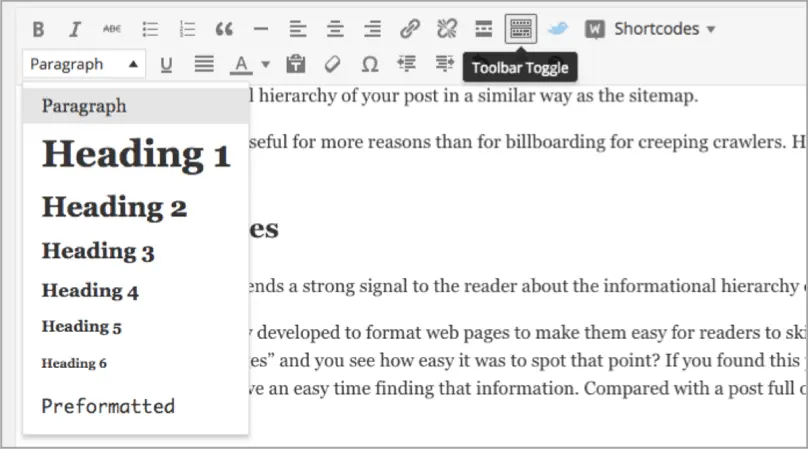
Search engines also give more weight to keywords in header tags. Putting important keywords in your header tags will also help your SEO ranking for those keywords.
5. Links going out
You can add more value and usefulness to your content by linking to authoritative sites that have more detailed information that your readers can use.
It is thought that linking to well-known authority sites will not only make your content more relevant and keep people on your site longer, but it will also send trust signals to Google and help your SEO score.
But more doesn’t always mean better. Too many links to other sites can be annoying and make it hard to read the information.
6. Different types of media
Images, videos, slideshows, and sound can make the user experience better and help you present information in a way that works best for the people who are most likely to visit your site.
They also let search engines know that the material is good—after all, you worked hard to make it look good and be interactive.
Video marketing is becoming an even more important part of getting users to interact with and buy from you. It has been found that websites with videos have a 4.8% higher conversion rate than websites without videos, which is 2.9% on average.
People stay on a website longer and remember more when it has videos.
How to improve your SEO through video vs. text
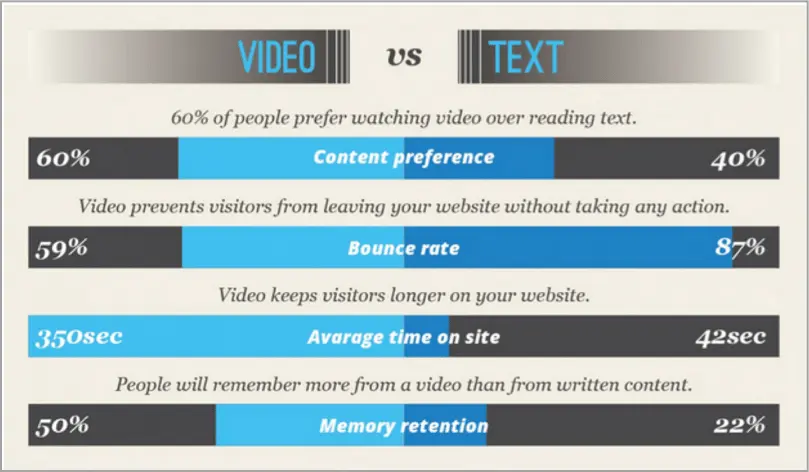
7. Fixing broken links will help your SEO.
No one wants to see a 404 page when they click on a link. Broken links make it hard to use.
Also, search engines see a lot of broken links as a sign of an old site that hasn’t been updated in a while, which can hurt your SEO score.
The good news is you don’t have to manually look for broken links on every page of your website. These programs and applications can assist you verify that your website is free of broken links:
8. Reading ease
Your audience probably doesn’t want to have to read a PhD dissertation every time they visit your website and read your material, even if they are very smart. They shouldn’t give up on reading your content and click away because it’s too hard to understand.
An easy-to-read and understand material will be more helpful to readers. Furthermore, some experts believe that Google ranks websites according on their readability.
You can utilize a lot of resources to see how easily your material reads, including
- Click this link to visit Readability-Score.com.
- Checker provides statistics on readability
- The MS Word 9 Readability
9. Organizing and composition
People will stay on your website longer and read more of its contents if it has easy-to-read and understandable structure and layout.
A webpage can be far more helpful if its material is formatted to be easily readable:
- Assure that the sizes and fonts are readable.
- Use strong type and colours sparingly and at the appropriate places to make the content easy to read and highlight significant information.
- People dislike reading a wall of text, so keep your sentences brief and give enough of room between them.
- Lists using numbers or bullet points will help to clarify things.
- Use technologies like huge drop-down menus, modal windows, structured grids, sliders, tabs, and progressive layouts to organize and make content more engaging.
- Use subheadings to divide the text into parts. Putting keywords in the header tags in the right way also helps your SEO score.
10. Page to contact us
This Google paper (p.98) says that websites with enough contact information are seen as more reliable by search engines and may therefore rank higher.
Including a link to your “Contact Us” page in the menu bar of your website will improve its usability (especially if you run an e-commerce site) and may also improve its search engine optimization.
A contact form that is well-designed increases website interaction for a company. Along with other things, it facilitates the discovery of new business opportunities, the acquisition of fresh leads, and improved customer service.
Visual representation of a “Contact Us” page.
Use of a contact page is one approach to raise your SEO.
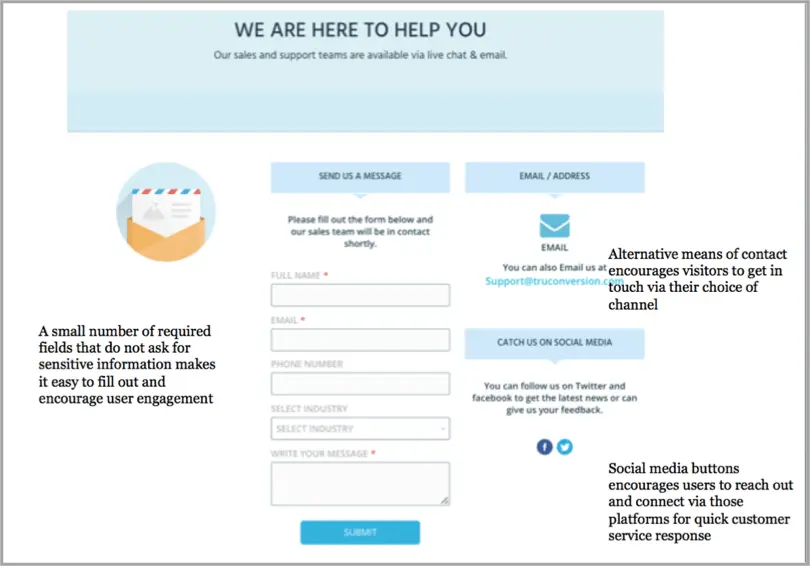
11. A website can improve its SEO depending on its design and structure.
+When a user cannot discover what they need on a website, they are leaving it quickly as seen by a high bounce rate, short stay time, and low number of pages viewed.
If you have well-considered site architecture and easy access, visitors will be able to locate what they’re searching for, finish their jobs, and return to your site more than once.
A “flat” website design makes material easy to access and, by displaying connections to all the significant pages, can improve your SEO ranking. This makes it easier for search engines to crawl the whole site.
Site design is one way to make your SEO better.
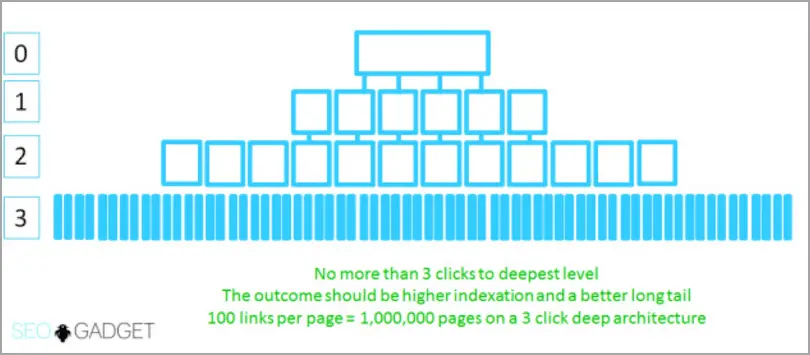
A clear and simple example of a website’s navigation.
Use of web navigation is one approach to raise your SEO.
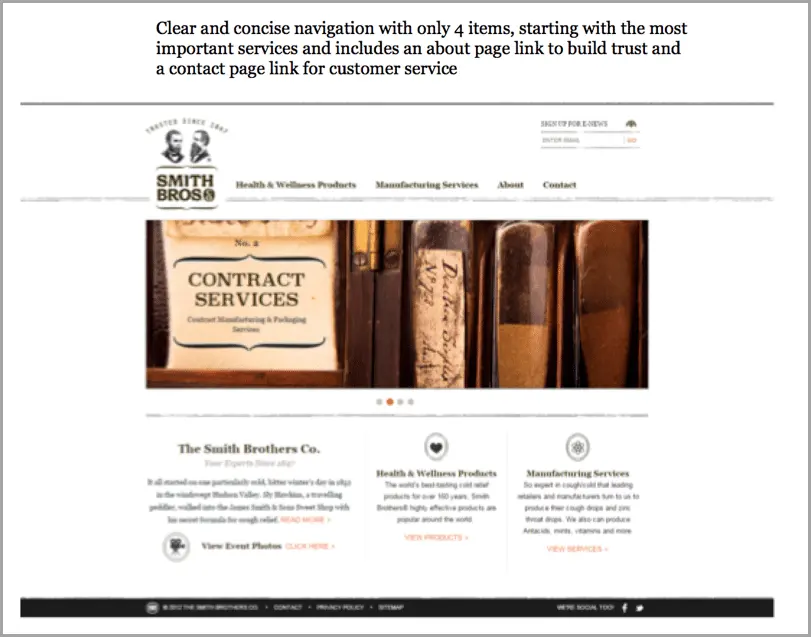
12. Mobile optimization
Google began penalising non-mobile-friendly websites in April 2015 by reducing their search engine ranking.
Conversions and the user experience will suffer if your website is not mobile-friendly because more and more people are reading on their phones.
It is very important for marketing who work with businesses. A study found that 77% of business leaders use their smartphones to look up information about a product or service for their company.
Mobile phones are used by business leaders to look up goods and services for their companies.
One way to improve your SEO is to use mobile optimisation.

It’s not just for business-to-business sites. It was found that 55% of all searches are done on mobile devices by search engines like Yelp that connect people with companies.
If your site has been around for a while, you should check it out to make sure it follows the rules.
More people are connecting to the Internet on their phones than on their computers.
A good example of how to improve your SEO is the Comscore mobile graph.
13. Spreading the word
SEO rank can be changed by the number of Facebook shares, Tweets, Pinterest pins, and other social media comments.
By adding social sharing buttons to your website, you can make it easier for people to share your content, which improves the user experience. It can also help your website rank higher in search results.
Sharing on social networks also makes people more likely to buy something. About 43% of Facebook users who liked, shared, or commented on an item later bought it, and nearly 10% of Twitter users who liked, shared, or commented on an item later bought it.
As shown in this case study, a pest control business increased its organic traffic by 15% in just two weeks after running a campaign to get more people to share their social media posts.
Peep Laja got over 40,000 unique visitors to his site in the first month. Most of that traffic came from people sharing his posts on social media.
If you want to start, try these social share button plug-ins:
- What is SumoMe?
- Sharing a lot
- Sharing on WP Social
What tool should I use to improve my SEO?
Want an SEO tool that can check how well your website works for everyone?
The tool that we suggest is SEMrush.
If you use SEMrush, you can:
- Do a technical SEO audit of your website to find important user problems.
- Keep track of where you stand in search results.
- Look at what your competitors are doing and come up with smart ways to rank higher than them in search results.
- Find personalised tips on how to get more search traffic.
- Check your backlink profile and make changes as needed to keep your SEO from suffering.
Here you can try SEMrush for free for 7 days.
Fix the problem where usefulness and SEO “best practice” don’t work well together to improve SEO.
Most of the time, things that make something easier to use also help its SEO score. There are, however, times when disagreement may happen:
- A lot of content writers “stuff” buzzwords on a page to boost its SEO, but this could make the content harder to read and less enjoyable for users.
- When someone tries to use buzzwords in an article, it can change the words they use, which can make the content hard to understand.
- Even though outbound links can help with SEO, having too many of them can be annoying, especially if they don’t have anything to do with the current topic.
- It may help your SEO score to have an extensive footer that lists every page on your site, but it makes it hard for visitors to find key pages.
You may have to choose between getting more traffic from SEO and giving your users the best experience every once in a while, especially in the short run.
Don’t get sucked into comparing numbers like page views and visitors. In the short term, SEO traffic may give you more numbers, but a better user experience can often lead to more sales.
To get more sales and conversions in the long run, it’s often smarter to focus on user experience instead of trying to get as many SEO tricks as possible.












